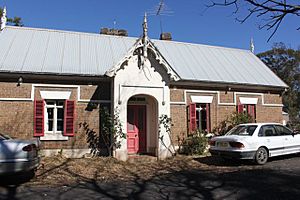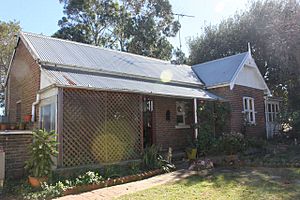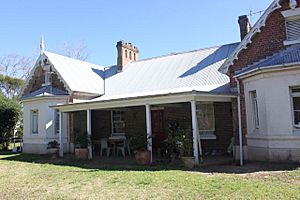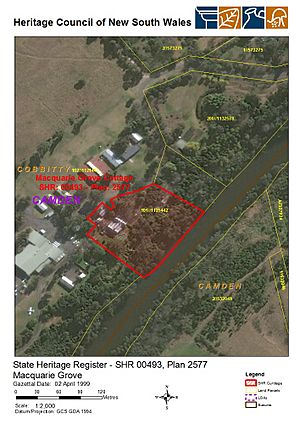Macquarie Grove facts for kids
Quick facts for kids Macquarie Grove |
|
|---|---|
 |
|
| Location | Aerodrome Road, Cobbitty, Camden, Camden Council, New South Wales, Australia |
| Built | 1812–1850 |
| Architectural style(s) | Victorian Rustic Gothic |
| Official name: Macquarie Grove | |
| Type | State heritage (built) |
| Designated | 2 April 1999 |
| Reference no. | 493 |
| Type | Cottage |
| Category | Residential buildings (private) |
| Lua error in Module:Location_map at line 420: attempt to index field 'wikibase' (a nil value). | |
Macquarie Grove is a historic property located in Cobbitty, near Camden, Australia. It started as a private home and later became offices for an airport. Today, it is a private home again. This special place was built between 1812 and 1850. It is recognized on the New South Wales State Heritage Register because of its important history and unique style.
Contents
The Story of Macquarie Grove
Early Days and First Settlers
When the first European settlers arrived in Sydney Cove in 1788, they soon found the soil wasn't good for farming. They looked for better land. By 1795, they found the rich area called the Cowpastures. This area got its name because a herd of wild cows, which had escaped the colony, was found grazing there. Today, this is the Camden district.
Wealthy colonists saw this land as perfect for raising animals and setting up large farms. The gentle hills and wide grassy areas reminded them of English country estates. They wanted to own big pieces of this land.
How Land Grants Shaped the Area
In 1812, the new governor, Lachlan Macquarie, decided to open up the land north of the Nepean River. He had the land measured and then gave out the first large land grants. These grants were huge plots of land given to important and wealthy colonists.
One of these large grants, about 400 acres (162 hectares), was given to Rowland Hassall in 1812. Rowland Hassall was an early settler who arrived in 1798. He became a successful farmer and sheep breeder. He also worked for the government, managing livestock in the Cowpastures region.
The Hassall Family's Legacy
Rowland Hassall named his new property Macquarie Grove. Around 1813, he built the first farmhouse, which is now called Hassall Cottage. Governor Macquarie himself visited the farm in 1815 and called it "finely appointed and beautiful."
After Rowland Hassall passed away in 1820, his son, Samuel Otoo Hassall, took over Macquarie Grove. Samuel continued to run the farm. As the nearby Camden township grew, Samuel's son, James Mileham Hassall, built a bigger main house, also called "Macquarie Grove," around 1840. The original farmhouse was then renamed "Lucyville."
Later, due to floods in the 1860s, James Mileham Hassall moved his family. He leased Macquarie Grove to a schoolmaster, William Gordon, who used it as a boys' school.
New Owners and a Summer Retreat
As the Hassall family's money decreased, James sold Macquarie Grove in 1877. The new owner was Henry Carey Dangar, a rich farmer and horse racing fan. Dangar didn't plan to use Macquarie Grove as a business. Instead, it became his family's summer home for three months each year. The farm also provided food like butter, eggs, and poultry for their Sydney home. It was also a place for their farm animals and retired racehorses.
Over the years, Macquarie Grove had several different owners for short periods. Finally, in 1916, Arthur Macarthur-Onslow bought the property. He was the great-grandson of John Macarthur, a famous pioneer in the district. Arthur used the property as a sheep farm and part of a dairy farming plan.
From Farm to Flying School
Arthur's second son, Edward Macarthur-Onslow, loved aviation. In 1937, he sold all the sheep and turned the old horse racetrack into a private airport. He started the Macquarie Grove Flying School. Here, people learned to fly, glide, and parachute.
Edward and his wife, Winifred, lived in a restored cottage on the property, which they called "April Cottage." Later, they moved into the main Macquarie Grove house, and Edward's mother, Sylvia, moved into the smaller cottage, renaming it "Hassall Cottage."
The Macquarie Grove Flying and Glider School officially opened on September 30, 1939. A government minister, James Fairbairn, attended the opening.
Macquarie Grove During Wartime
Soon after, World War II began. Edward Macarthur-Onslow joined the war effort. Instead of closing the airport, he made an agreement with Minister Fairbairn. The government would use the property as an air force base during the war. To do this, they bought more land nearby and made the runway longer.
In 1940, the government officially took over 468 acres (190 hectares) of Macquarie Grove for defense and aviation. The Macarthur-Onslow family kept only 15 acres (6 hectares), including Hassall Cottage. The main Macquarie Grove house was used as officers' quarters.
After the war, the Royal Australian Air Force stayed at Macquarie Grove for some time. The Macarthur-Onslow family tried to get their property back but couldn't. In 1946, Edward was able to lease the land for five years and reopen his flying school. It wasn't until 1987 that the family could buy back small parts of their original land, including the cottages. The rest of the land, the 468 acres, is still owned by the government and is now Camden Airport.
What Does Macquarie Grove Look Like?
Macquarie Grove is a beautiful brick house with a style called Victorian Rustic Gothic. It sits on a hill, looking out over the Nepean River and the town of Camden. This style often uses brick and stone, with steep roofs and fancy wooden decorations called bargeboards. The house is placed to make the most of the lovely views around it.
The original house had four rooms. Later, two balanced sections were added to each end, making the house look like the letter "H" from above. These new sections have brick walls, special plastered areas around the windows, and bay windows that stick out. They also have detailed wooden bargeboards with pointed decorations called finials. The brick chimneys are in a Victorian style, and there's a decorative Gothic-style porch on one side. The roofs are made of corrugated iron.
Around the main house, there are other buildings, like a small cottage (which was once a nursery) and a garage that is now a studio. These buildings create a nice enclosed garden area at the back.
The property also has some old and important trees. These include a white cedar tree, a common holly tree, and a very old camphor laurel tree. Experts believe the camphor laurel tree might be from the mid-1800s!
Changes Over Time
- Early 1900s: Outbuildings were built, including brick servant's quarters and a weatherboard nursery.
- 1940s: These outbuildings were changed to be used for aviation defense during the war. A brick garage was also built.
Why is Macquarie Grove Important?
Macquarie Grove is very important to the history of New South Wales. It was part of a huge 400-acre (162-hectare) land grant given by Governor Lachlan Macquarie in 1812. This was one of the very first large land grants in the Cowpastures district. Macquarie Grove was the second house built on this land, but it became the main home for the property.
The property is also important because of the famous people and families who lived there. It was first given to Rowland Hassall, then owned by Henry Carey Dangar, and later by Arthur Macarthur-Onslow. The Macarthur-Onslow family has had a long connection to the property, even buying parts of it back from the government in 1987.
Macquarie Grove is also linked to the history of flying. It was home to the Macquarie Grove Flying and Glider School. During World War II, the Australian government used it as an air force base. After the war, this site became the Camden Airport.
Here's why Macquarie Grove is considered so important:
- It shows how history unfolded in New South Wales: It was one of the first large land grants in the area, showing how the colony grew. The house itself was built around the same time the Camden township was being formed.
- It's connected to important people: Many significant figures, like Governor Macquarie, Rowland Hassall (a missionary and farmer), Henry Carey Dangar (a prominent landowner), and the Macarthur-Onslow family (pioneers in the district), were connected to Macquarie Grove.
- It's a beautiful example of architecture: The house is a lovely example of the Victorian Rustic Gothic style. It was built to take advantage of the beautiful views of the Nepean River and the surrounding landscape. Governor Macquarie even called it a "finely appointed and beautiful farm." The property also has important old trees, like the camphor laurel tree from the mid-1800s.
- It has historical research potential: Because it's such an old property, there's a chance that further study could uncover even more information about its construction and how it was used over time.
- It's a rare surviving example: Macquarie Grove is a rare example of an early homestead built on one of Governor Macquarie's first land grants. It shows how wealthy colonists developed large country estates during that period.




